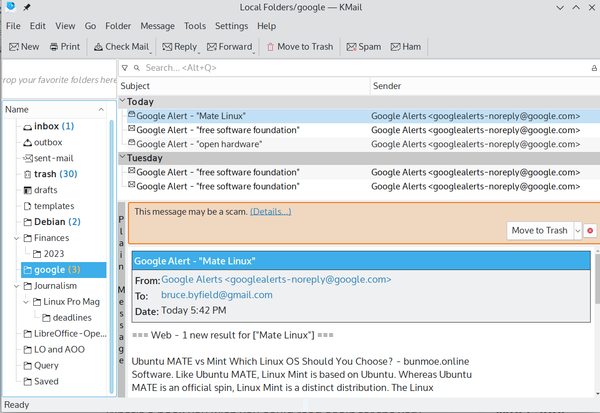Another look at KDE Plasma's email client
KMail Revisited

Photo by Mariia Shalabaieva on Unsplash
KMail offers a rich feature set, but a number of minor nuisances persist, making it a less than ideal email client.
When KDE Plasma became my main desktop environment 15 years ago, I switched my email from Evolution to KMail (Figure 1). At first, I was impressed. Even back then, KMail was a mature application, with more features than most other alternatives. However, mounting problems, including security difficulties that locked me out of my account, eventually made me a happy user of Claws Mail for over a decade. But when an upgrade to Debian 12 left Claws Mail dysfunctional for obscure reasons, I decided to save some troubleshooting and give KMail another try. Surely, I thought, in the intervening years, KMail had corrected its problems.

The Feature Set: Part of the Story
At its best, KMail combines automation with a well-considered feature set. Naturally, it includes standard features for email clients, such as a signature file and a spell check, but KMail’s standard features are designed to be understandable at a glance, while often offering a variety of choices. For example, the default pane for displaying emails provides another level of organization by displaying the date emails were received on a separate line, providing much-needed space for the subject and sender fields. However, a dozen sorting criteria are available for the emails themselves and can be easily changed if necessary (Figure 2). Emails can also be displayed separately or in threads that can be expanded or collapsed as needed.
[...]
Buy Linux Magazine
Subscribe to our Linux Newsletters
Find Linux and Open Source Jobs
Subscribe to our ADMIN Newsletters
Support Our Work
Linux Magazine content is made possible with support from readers like you. Please consider contributing when you’ve found an article to be beneficial.

News
-
Say Goodbye to Middle-Mouse Paste
Both Gnome and Firefox have proposed getting rid of a long-time favorite Linux feature.
-
Manjaro 26.0 Primary Desktop Environments Default to Wayland
If you want to stick with X.Org, you'll be limited to the desktop environments you can choose.
-
Mozilla Plans to AI-ify Firefox
With a new CEO in control, Mozilla is doubling down on a strategy of trust, all the while leaning into AI.
-
Gnome Says No to AI-Generated Extensions
If you're a developer wanting to create a new Gnome extension, you'd best set aside that AI code generator, because the extension team will have none of that.
-
Parrot OS Switches to KDE Plasma Desktop
Yet another distro is making the move to the KDE Plasma desktop.
-
TUXEDO Announces Gemini 17
TUXEDO Computers has released the fourth generation of its Gemini laptop with plenty of updates.
-
Two New Distros Adopt Enlightenment
MX Moksha and AV Linux 25 join ranks with Bodhi Linux and embrace the Enlightenment desktop.
-
Solus Linux 4.8 Removes Python 2
Solus Linux 4.8 has been released with the latest Linux kernel, updated desktops, and a key removal.
-
Zorin OS 18 Hits over a Million Downloads
If you doubt Linux isn't gaining popularity, you only have to look at Zorin OS's download numbers.
-
TUXEDO Computers Scraps Snapdragon X1E-Based Laptop
Due to issues with a Snapdragon CPU, TUXEDO Computers has cancelled its plans to release a laptop based on this elite hardware.

